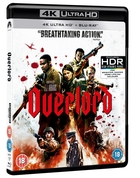BLU-RAY REVIEW

Overlord 4K Ultra HD
Featured In Issue 240, June 2019
"Overlord" is a genre mash-up and an insanely twisted thrill ride about a team of American paratroopers who come face-to-face with Nazi super-soldiers unlike the world has never seen. (Gary Reber)
Special features include The Horror of War featurettes: "Creation" (HD 11:04), "Death Above" (HD 07:18), "Death On The Ground" (HD 09:16), "Death Below" (HD 06:25), "Death No More" (HD12:19) and "Brothers In Arms" (HD 05:03); and a digital code.
The 2.40:1 2160p HEVC/H.265 Ultra HD HDR10/Dolby Vision picture, reviewed on a Sony Bravia Z9D 4K Ultra HD HDR display, was photographed digitally in anamorphic Panavision® using the Arri Alexa Mini and SXT, as well as Panavision camera systems and sourced from a 2K (not 4K) master Digital Intermediate format. As the 2K Digital Intermediate has been upconverted to 2160p, there is no real gain in native resolution. Overall, the picture appears drab with an attempt to create a filmic appearance. The imagery is dense and dark with low lighting throughout of interiors and nighttime exteriors and gloomy overcast daytime scenes. Colors are drab in such earthy environments and within the dreary underground laboratory where experiments on villagers are performed. The only color intensity is exhibited in explosions and the blood of wounds and mutated body parts. Fleshtones appears natural within the dark environments. HDR contrast is limited as the overall picture is dark and black levels are shy of pure blackness. Resolution is satisfying with strong textures revealed on the well-worn military uniforms, rough stone buildings, rubble and the objects in the Nazi laboratory. There are no worthy segments that exhibit WOW! The overall appearance is gloomy exteriors and dull, dark interiors. While this is overall a dark picture, the viewing experience is effectively compelling. (Gary Reber)
The Dolby Atmos/Dolby TrueHD 7.1-channel soundtrack is a tour de force of sonic mayhem with an aggressively active holosonic® soundfield. Action scenes are strongly enveloping with aggressive panned and directionalized sound effects and atmospherics, making effective use of each loudspeaker channel, including the extension of sub-25 Hz bass in the .1 LFE channel. The sonics are effective in their depiction of a wartime on the edge. Sound effects and atmospherics include a plane full of paratroopers who all do make the treacherous drop, the plane's engine hum and rattles, the sound of artillery and bullets ripping the plane's housing, explosions pounding in the sky all around the plane and soldiers screams. This is war with mayhem and chaos unrelenting in confronting a horrific Nazi experiment. Dialogue throughout is intelligible The music spans the frontal soundstage and extends to the surrounds.
The Immersive Sound element is represented from the opening aggressive voice at the introduction followed by a spattering of brief sound effects such as bomb blasts, sharp fly-by transient effects, panned airplane fly-overs , buzzing sounds, various announcements over PA loudspeakers, gunfire, forest ambience with birds chirping, humming sounds, explosions and debris, and other atmospherics within the experiment laboratory. Unfortunately, while the ear-level soundtrack is well crafted, the upper layer is disappointing. The sound designers failed to project spherical dimensionality. The sound effects used are very short, within 1 to 5 seconds. In between are large gaps of silence. There is not even music extended to the height layer. Had the height layer been optimized, as with the ear-level soundfield, this would have been an even more exciting experience.
In summary, the ear-level soundfield is effectively defined and filled with enveloping sonics that heighten the experience of battles and dangerous situations. With regard to the ear-level presentation, this is a reference-quality soundtrack. (Gary Reber)

 then "Add to Home Screen"
then "Add to Home Screen"